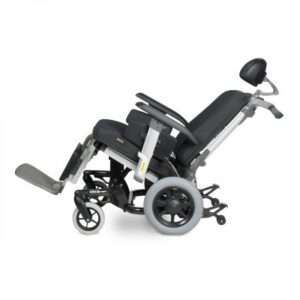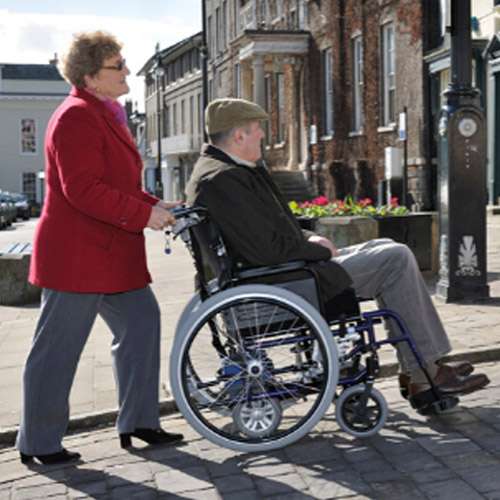How do wheelchair users prevent pressure sores? A common belief is that only people who are bedbound develop pressure sores. In reality, anyone can develop pressure sores and there are other factors that put certain people at a greater risk.
The NHS estimates that almost 500,000 people in the UK will develop at least one pressure sore in any given year.
Wheelchair users are among that group of people that are at higher risk. Individuals who are confined to their wheelchair for most of the day are at particularly high risk of developing pressure sores.
Here, we go over the various ways a wheelchair user can stop pressure injuries from developing.
Jump straight to…
What is a Pressure Sore & Why Do They Develop?
Also known as pressure ulcers or bedsores, this common injury is caused when persistent pressure is placed on an area of skin, usually over bony prominences.
Pressure sores are skin injuries that develop when an area of skin is put under sustained pressure for a prolonged period of time. Placing excessive pressure on parts of the body such as the sacrum, coccyx & heels without alleviating said pressure from time to time will cause pressure ulcers to develop.
The severity of pressure injuries can vary and is measured in stages (1-4) ranging from skin discoloration and itchiness in the affected area through to deep open wounds which are extremely painful and can increase the risk of infection & sepsis.

Stages of pressure sore development
Regularly relieving pressure from the impacted area(s) is the most effective way to prevent pressure sores for wheelchair users. Let’s look at the different pressure relief techniques in wheelchairs and tools that are suitable for wheelchair users.
Pressure Relief Exercises for Wheelchair Users
Relieving pressure from a certain part of the body requires dispersing that pressure to another part of the body. Ideally, this pressure should be spread across a person’s body as evenly as possible to lessen the chance of pressure sores developing.
One of the best pressure sore prevention tips for wheelchair users is to regularly carry out specific pressure relieving movements.
It is important to ensure that wheelchair wheels are locked, and any belts are undone before attempting any exercises.
Here are some popular exercises to try:
• The push-up — Use the wheelchair armrests (or wheels if you don’t have any) to push up out of the seat with your arms. You should straighten your arms fully so that your elbows are locked. Then ensure that the buttocks and lower back are fully out of the seat.
• The forward lean — Lean forward as far as you can — imagine that you are trying to rest your chest on your knees! This movement is particularly good for relieving pressure on the coccyx.
• Leaning side-to-side — Whilst seated, shift your body weight onto your left side to lift your right side out of your seat. Then repeat on the other side. Like the push-up, this movement relieves pressure from the buttocks and the lower back. Because this is a more subtle movement it’s easier to perform whilst you’re out and about.
The purpose of these exercises is to shift your body weight around in the wheelchair, relieving pressure from the areas where it is most commonly felt.
General advice suggests performing each movement for 15 seconds for every 15 minutes of wheelchair use. So, if you had been sat in your wheelchair for 30 minutes, you would exercise for 30 seconds. But we always recommend speaking to your doctor/physio/occupational therapist to find out what is best for you.
Any of the three movements mentioned above can be performed independently, or with assistance, depending on individual mobility levels.
Pros & Cons of Wheelchair Exercises for Pressure Relief
| Pros | Cons |
| No specialist equipment required | Requires some degree of mobility, or someone who is available to assist the user frequently |
| Only a short period of time is required to complete the exercises | Wheelchair users may feel uncomfortable performing the exercises in public |
| Encourages regular movement in those using a wheelchair as part of a recovery programme | Requires the cognitive abilities to remember to perform the movements at regular intervals |
Have any tips or experiences preventing pressure sores?
Get The Correct Wheelchair Sizing
It may also be the case the case that a wheelchair user is experiencing pressure ulcers, because the wheelchair sizing is incorrect. It is important to ensure that seating dimensions are specifically for the person using the wheelchair to avoid injury in the long-term.
As seating specialists advising in pressure care regularly, we have found that if a care chair has a seat depth that is too high, then the user’s feet won’t be properly supported and 94% of their body weight will be going through their buttocks and thighs! That seriously increases the pressure levels in those areas.
Read about the importance of tilt-in-space in care chairs here or download our specialist seating assessment guide.
These principles also apply to wheelchairs, so getting the seat properly sized is crucial for wheelchair pressure relief and avoiding ulcers.
Tips For Seat Size Measurements
The key measurements to take are:
- Seat Height
- Seat Depth
- Seat Width
- Armrest Height
- Back Height

A tape measure should be used to take the required measurements
Getting these seat sizing measurements correct is key. If the measurements are inaccurate then the user is at an increased risk of developing pressure sores, as well as poor posture and other issues.
Similar issues can also occur when using a pressure relief cushion in an incorrectly sized wheelchair.
Plus, because pressure sores can start developing in just a few hours it is important that sizing is correct from day one.
For your peace of mind, visit our showroom. Our experienced team will take all your seating measurements and have been advising on custom-built wheelchairs for decades!
We can offer advice on whether your existing wheelchair is the right fit for you or take measurements to help you choose your new wheelchair.
Tilt In Space Wheelchairs
If a wheelchair user is unable to exercise at all, it may be correct for that patient to have a pressure relieving tilt-in-space wheelchair that disperses pressure across the body and lessens the chance of developing pressure sores developing.
This is the most direct of all the pressure sore prevention in wheelchair techniques, specially designed tilt-in-space wheelchairs come with built-in features for positioning, posture support, and pressure relief.
Using the same movement functions that you may recognise from tilt-in-space riser recliner chairs, these tilt-in-space wheelchairs are ideal for pressure relief as they are able to tilt the wheelchair whilst maintaining correct body positioning for the user with hip and knee angles at 90 degrees.
This tilting allows the user to reposition their body weight to stop pressure building up in one area, without compromising proper posture.
Different wheelchair models have different ranges of tilt. For example, the Ibis Tilt In Space Wheelchair allows a 30-degree tilt adjustment which can be easily operated by both the user or their carer.

Ibis tilt-in-space wheelchair tilts to evenly distribute pressure across the users body.
Summary
There are several ways to reduce pressure injuries in wheelchair users. The best techniques involve the prevention of pressure sores developing initially. From pressure relief in wheelchair users, to having a bespoke tilt-in-space wheelchairs that suits your needs.
Ideally, a combination of these is the most effective way to reduce the risk of pressure sores developing. However, not everyone can perform exercises and pressure relief aids cause discomfort for some.
Contact us or arrange a no-obligation assessment to find out what is best for you. If you are local and you prefer a more personal touch, come down to our showroom where our experienced specialists can talk you through all our options.
Arrange a Free, No Obligation Assessment
The most immediate thing that a wheelchair user can do is check to ensure that their wheelchair has the correct sizing dimensions for them.
FAQs
What causes pressure sores in wheelchair users?
Pressure sores, also known as pressure ulcers, are caused by prolonged pressure on certain areas of the skin, particularly over bony prominences like the tailbone, heels, and hips. In wheelchair users, sitting in one position for extended periods without relieving pressure increases the risk of developing sores.
How often should wheelchair users perform pressure relief exercises?
General recommendations suggest performing pressure relief exercises every 15 minutes. This can involve leaning forward, pushing up on the armrests, or shifting side to side to redistribute body weight and relieve pressure on key areas.
How does improper wheelchair sizing lead to pressure injuries?
If a wheelchair’s seat is too deep, too narrow, or lacks proper support, it can increase pressure on certain areas like the thighs and buttocks, leading to pressure sores. Correct seat height, depth, and width are crucial to maintaining good posture and minimizing pressure build-up.
What is a tilt-in-space wheelchair, and how does it help prevent pressure sores?
A tilt-in-space wheelchair allows the user to adjust their body angle while maintaining proper posture. By tilting the chair, weight is redistributed across the body, which helps prevent pressure from building up in one area, reducing the risk of sores.
Can pressure relief cushions help prevent pressure sores in wheelchairs?
Yes, pressure relief cushions are designed to distribute body weight more evenly and reduce the risk of pressure sores. However, if the cushion or the wheelchair is not correctly sized for the user, it may actually increase the risk of injury rather than prevent it. Proper assessment and fitting are essential.














